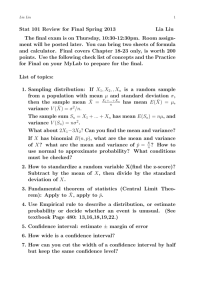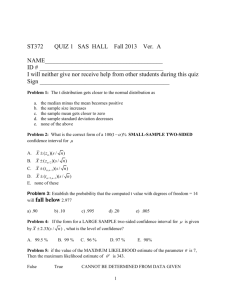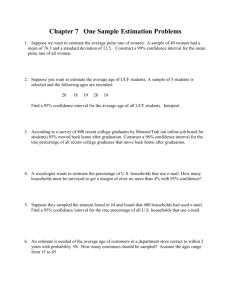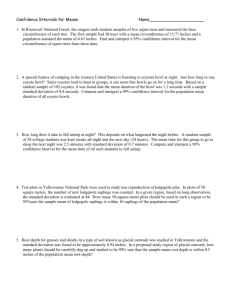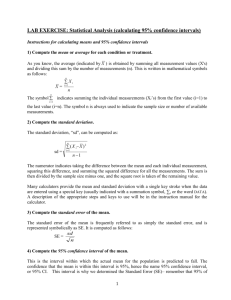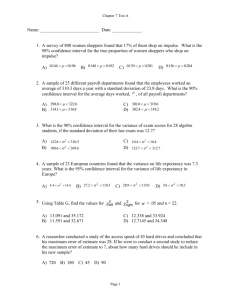PS9 Solution - Department Of Economics
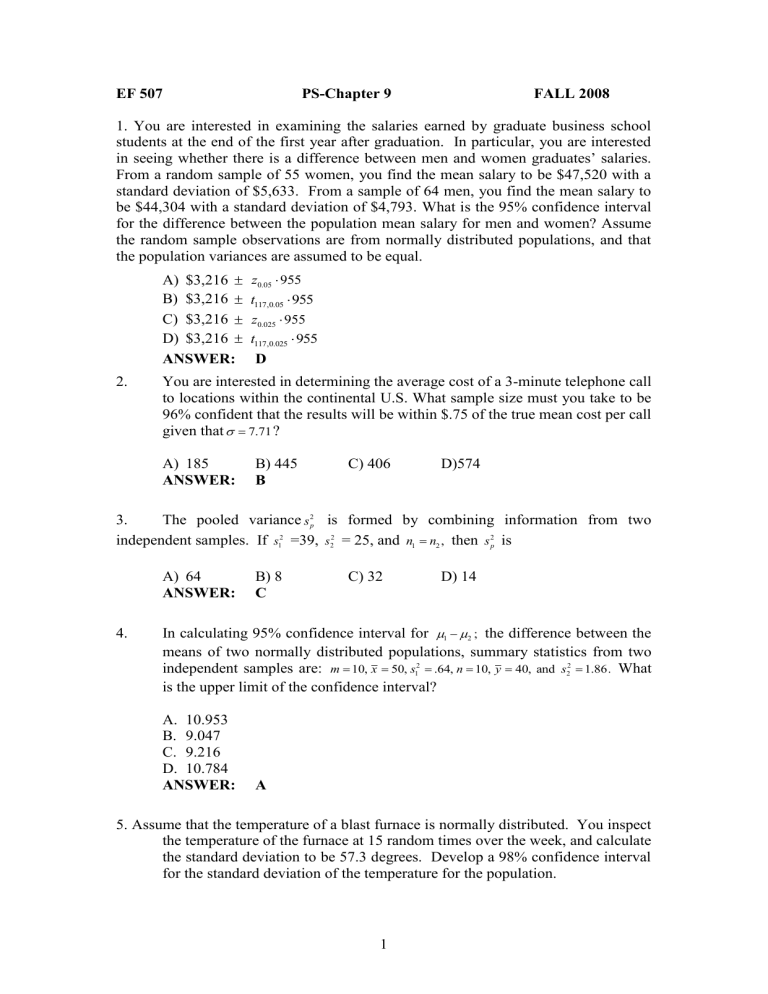
EF 507 PS-Chapter 9 FALL 2008
1. You are interested in examining the salaries earned by graduate business school students at the end of the first year after graduation. In particular, you are interested in seeing whether there is a difference between men and women graduates’ salaries.
From a random sample of 55 women, you find the mean salary to be $47,520 with a standard deviation of $5,633. From a sample of 64 men, you find the mean salary to be $44,304 with a standard deviation of $4,793. What is the 95% confidence interval for the difference between the population mean salary for men and women? Assume the random sample observations are from normally distributed populations, and that the population variances are assumed to be equal.
A) $3,216
B) $3,216
z
0.05
955 t
117,0.05
955
C) $3,216
D) $3,216
z
0.025
955 t
117,0.025
955
ANSWER: D
2. You are interested in determining the average cost of a 3-minute telephone call to locations within the continental U.S. What sample size must you take to be
96% confident that the results will be within $.75 of the true mean cost per call given that
7.71
?
A) 185 B) 445
ANSWER: B
C) 406 D)574
3. The pooled variance s 2 p
is formed by combining information from two independent samples. If s 2
1
=39, s
2
2 = 25, and n
1
n
2
, then s 2 p
is
A) 64 B) 8
ANSWER: C
C) 32 D) 14
4. In calculating 95% confidence interval for
1
2
; the difference between the means of two normally distributed populations, summary statistics from two independent samples are: m
10, x
50, s 2
1
.64, n
10, y
40, and s 2
2
1.86.
What is the upper limit of the confidence interval?
A.
10.953
B.
9.047
C.
9.216
D.
10.784
ANSWER: A
5. Assume that the temperature of a blast furnace is normally distributed. You inspect the temperature of the furnace at 15 random times over the week, and calculate the standard deviation to be 57.3 degrees. Develop a 98% confidence interval for the standard deviation of the temperature for the population.
1
ANSWER:
2
14, 0.01
= 29.14,
2
14, 0.99
= 4.66.
N =15, s = 57.3,
/ 2 = 0.01. Then df = n -1=14 and
6. Assume that the number of packages processed daily at the local post office is normally distributed. Assume that over 20 days, the standard deviation of the number of packages processed was 39.3. Develop a 99% confidence interval for the population standard deviation.
ANSWER: n =20, s = 39.3, df = n -1=19,
/ 2 = 0.005. Then,
2
19, 0.005
=
38.582 and
2
19, 0.995
= 6.844
UCL= (n -1) s
2
/
2
/ 2
= (19)(1544.5)/6.844 = 4287.77
LCL= ( n -1) s
2
Hence 760.6<
/
1
2
/ 2
2
=(19)(1544.5)/38.582 = 760.6
4287.77
, and then 27.58<
<65.48
7. Suppose, for a random sample of 250 firms that revalued their fixed assets, the mean ratio of debt to tangible assets was 0.528 and the sample standard deviation was 0.151. For an independent random sample of 500 firms that did not revalue their fixed assets was 0.502 and the sample standard deviation was
0.162. Find a 99% confidence interval for the difference between the two population means.
ANSWER: n x
250, x
0.528, s x
0.151, n y
500, y
0.502, s y
0.162, z
.005
2.575
The 99% confidence interval for the difference between the two population mean scores is
( x
y )
z
/ 2
( s 2 x
/ n x
) ( s 2 y
/ n y
)
(0.528 – 0.502)
(2.575)((0.01199)
= 0.026
0.031 or -0.005 <
x
y
< 0.057
8. Find the lower and upper confidence limits for a 95% confidence interval of the population variance given a sample of size 25, a sample variance of 81, and that the population distribution is normal.
ANSWER:
Since
2 n 1,1
/ 2
2
24,0.975
12.40 and
2 n
2
24,0.025
39.364
, then the lower and upper confidence limits for a 95% confidence interval of
LCL = ( n
1) s
2
/
2 n
(24)(81) / 39.364 = 49.385
UCL = ( n
1) s
2
/
2 n 1,1
/ 2
(24)(81) / 12.40 = 156.774
2 are
9. The economics department secretary wants to estimate the average number of bottled drinks sold each day out of the vending machine. Similar vending machine sales have a standard deviation of 9 bottles per day. She wants to be
95% confident that the estimate, x , obtained is within 3 bottles of the true mean . How large a sample is needed?
ANSWER: n
z
2
/ 2
2
/ ME
2
1.96
2
34.57
35
2



